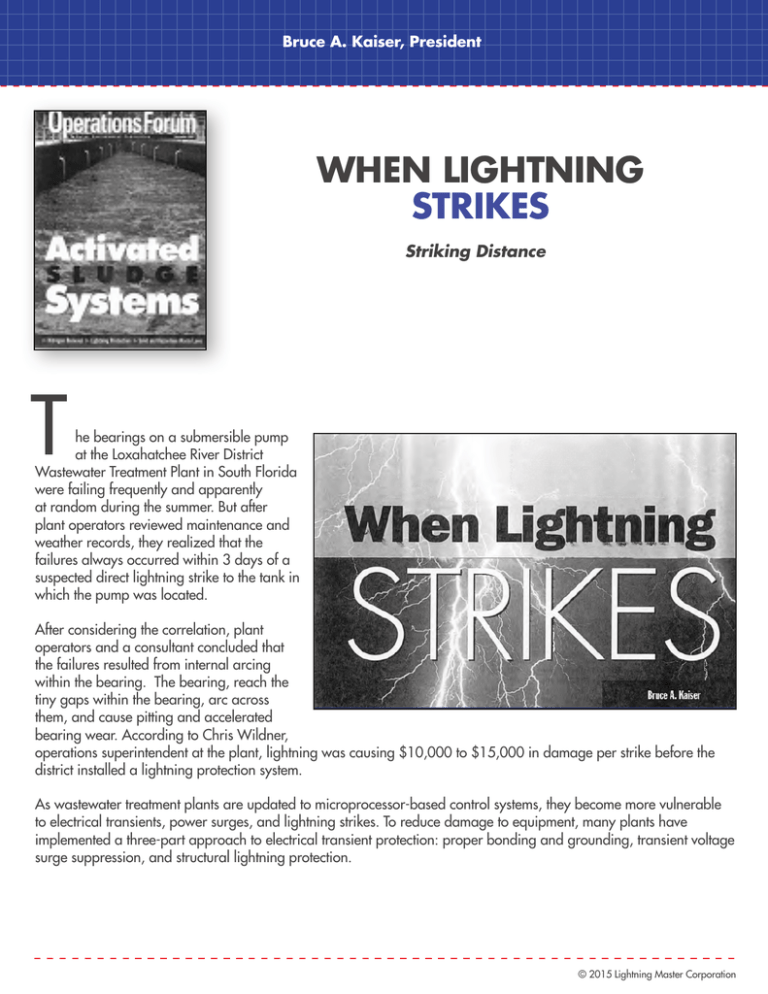WHEN LIGHTNING STRIKES - Lightning Master Corporation
advertisement

Bruce A. Kaiser, President WHEN LIGHTNING STRIKES Striking Distance T he bearings on a submersible pump at the Loxahatchee River District Wastewater Treatment Plant in South Florida were failing frequently and apparently at random during the summer. But after plant operators reviewed maintenance and weather records, they realized that the failures always occurred within 3 days of a suspected direct lightning strike to the tank in which the pump was located. After considering the correlation, plant operators and a consultant concluded that the failures resulted from internal arcing within the bearing. The bearing, reach the tiny gaps within the bearing, arc across them, and cause pitting and accelerated bearing wear. According to Chris Wildner, operations superintendent at the plant, lightning was causing $10,000 to $15,000 in damage per strike before the district installed a lightning protection system. As wastewater treatment plants are updated to microprocessor-based control systems, they become more vulnerable to electrical transients, power surges, and lightning strikes. To reduce damage to equipment, many plants have implemented a three-part approach to electrical transient protection: proper bonding and grounding, transient voltage surge suppression, and structural lightning protection. © 2015 Lightning Master Corporation lightningmaster.com LightningMaster Corporation BONDING AND GROUNDING Low-impedance grounding of any structure directs the energy from a direct lightning strike into the ground. Bonding involves connecting all of the electrical and metallic masses within a structure so they have the same electrical potential. A structure normally has several different services entering it: alternating current (AC) power line, telephone lines, and control and data lines. If these services enter the structure at multiple locations and each service is grounded at that location, the difference in ground potential on those services when lightning strikes can cause equipment damage. To help mitigate damage from transients, the AC service normally is established as the reference ground (see figure). At the main disconnect, the AC neutral and ground wires are bonded together, and a ground lead is grounded to a ground rod or to the site grounding system. The ground leads from the AC power disconnect. All data and control lines also are grounded to the lead ground. Once this is done, any differences in ground potential of the different services to the structure are equalized at one point. In a large structure, the same principle applies to grounding of equipment chassis within that structure. Each chassis is bonded to a bus bar, which is bonded to a master bus br, which is bonded to the common ground. This method ensures that all the services and equipment will be sampling ground potential at a common location. SURGE SUPPRESSION Because wastewater treatment plant structures are separated by relatively large distances, they are rarely at the same ground potential. Surge suppression, therefore, should be installed on all incoming services and on both ends of services between structures. To mitigate the effects of transients on wiring entering, leaving, and within a structure, transient voltage surge suppression devices, which limit the difference in potential between wires and between wires and the chassis ground, should be used. All-mode surge suppressors provide equalization of potential from phase to neutral (common mode). When there is a change in potential on any wire, the other wires change with it, protecting the equipment. The location of the surge suppression devices within the facility also is important. The most effective way to install surge suppression on AC power is to employ the staged-protection concept. Rather than install only one high-energy device at the service entrance, it is more efficient to install multiple devices in stages. When a surge reaches a facility, some of the transient energy can pass through the primary surge suppressor at the service entrance. Therefore, it is critical to have secondary devices to take care of the voltage that seeps through. Secondary surge suppressors on distribution subpanels take care of letthrough voltage and transients generated within a facility. Transient voltage surge suppression equipment is critical at all facilities, even those that never experience lightning. © 2015 Lightning Master Corporation lightningmaster.com LightningMaster Corporation Also, when planning the system’s layout, it is important to avoid routing unprotected wires adjacent and parallel to protected wires, where transients can be coupled from the unprotected wires to the protected wires downstream of the surge suppressor, rendering it ineffective. STRUCTURAL LIGHTNING PROTECTION The purpose of conventional lightning rod systems is to keep the structure from burning down, not to protect the electronic equipment inside a building. Therefore, more advanced lightning protection systems, such as those employing streamer-delaying technology, are necessary. Lightning strikes occur in a series of steps. The first step is the formation of stepped leaders from the storm cloud. When these stepped leaders reach about 500 ft. (150m) from the ground, their presence triggers the formation of streamers jumping up from objects on the ground. The first streamer to reach a stepped leader completes the strike. By slightly reducing the accumulation of ground charge and delaying the formation of streamers from the relatively small geographic area occupied by the protected structure, streamers from another point will win the competition to the stepped leaders. Streamer-delaying air terminals operate by reducing the accumulation of static ground charge on the structure and by delaying, the formation of the streamers from the protected structure, thus reducing the likelihood of streamers from the structure reaching the stepped leaders first and completing the lightning strike. The system should be installed on any portions of the facility where ground charge tends to accumulate and from which streamers tend to form, including buildings, towers, tanks, clarifiers, pumping stations, headwork, and light poles. Lightning is the most dramatic form transient. By solving the lightning problem, equipment automatically is protected from the more common types of transients caused by electric utility company switching, trees brushing against power lines, and traffic accidents with utility poles. Not only is the equipment protected from catastrophic damage, an environment is created in which the equipment will last longer and operate more reliably. Lightning damage takes four different forms: physical, secondary, electromagnetic, and ground potential change. Physical damage is caused by the current flow and heat of a lightning strike. An average lightning strike conveys an average of 20,000 amps can occur. The temperature at the core of the strike can reach five times the surface temperature of the sun. Secondary effect damage is caused by the motion of ground charge. During a lightning strike, the point on the surface of the earth at which the strike occurs is relatively vacated of ground charge. The area surrounding the point of the strike remains highly charge, causing an almost instantaneous potential gradient across the area. The surrounding area releases its charge to the point at which the strike occurred, causing a flow of ground charge. This © 2015 Lightning Master Corporation lightningmaster.com LightningMaster Corporation current flow can arc across any gaps in its path. The electromagnetic effect of lightning can induce transients into nearby conductors. A single lightning strike is made up of a series of flashes. This on-off action causes the electromagnetic field surrounding the strike to expand and collapse with the series of flashes. Changes in ground potential during a strike can introduce damage to equipment and components from the grounding system. If a facility is served by multiple services (AC power, telephone, data, coaxial cable) and the services are not commonly grounded, or if multiple chassis grounds exist, unwanted current flow can be introduced into facility wiring. Bruce Kaiser is president of Lightning Master Corp. in Clearwater, FL. © 2015 Lightning Master Corporation



